-
Welcome to the eG Forums, a service of the eGullet Society for Culinary Arts & Letters. The Society is a 501(c)3 not-for-profit organization dedicated to the advancement of the culinary arts. These advertising-free forums are provided free of charge through donations from Society members. Anyone may read the forums, but to post you must create a free account.
A question of flour
-
Similar Content
-
- 5 replies
- 405 views
-
- 2 replies
- 247 views
-
- 3 replies
- 612 views
-
- 11 replies
- 359 views
-
- 79 replies
- 7,857 views
-
-
Recently Browsing 0 members
- No registered users viewing this page.






Recommended Posts